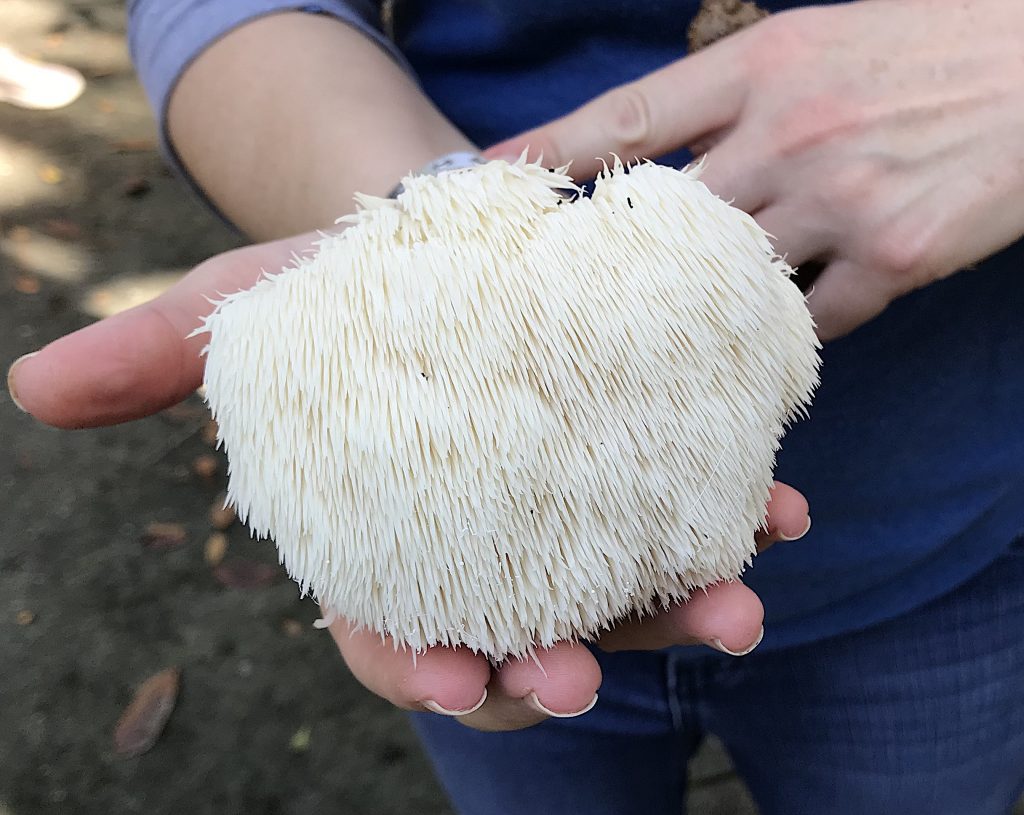
Lion’s Mane is an edible fungi that’s difficult to misidentify. Photo by Green Deane
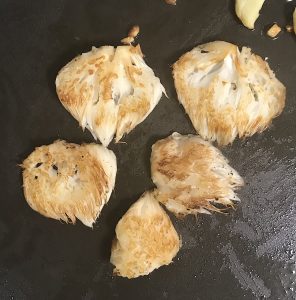
Lion’s Mane fries up nicely. Photo by Green Deane
We are shifting mushrooms seasons from terrestrial to trees or ground to wood. Instead of looking down we now look up. Milk caps and chanterelles are giving way to Oysters, Lion’s Mane and Chicken of the Woods. Edible fungi that like wood also often like cooler weather but not exclusively. There are oysters and chickens other times of the year but cool is prime time. Lion’s Mane, however, is one I see only after the season starts to turn cooler and only down to northern Florida. It’s a choice find. To my pallet raised on the coast of Maine it tastes like carb or lobster and I use it in similar ways. This particular specimen was found in a foraging class in Jacksonville last Saturday. You can read more about it here.
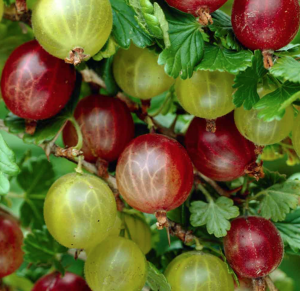
Gooseberries and currants come in several colors and flavors.
You won’t find wild Gooseberries or currants anywhere near The South. They like cool, humid weather: Think New England, Nova Scotia, Newfoundland, New Brunswick and west of there (and also possibly the tops of the Appalachian Mountain Chain.) There were several “blights” in the last century. One took out the American Elm and another the great Chestnut. A third took its toll on Gooseberries. They did not get the disease themselves, the White Pine Blister, but they were the intermediate host of the disease. As one might imagine a pine blister in the the Pine Tree State was serious business thus Gooseberries and currants had to go. Legions of Boy Scouts and WPA workers destroyed it where they found it. But, I do remember seeing them in the wild. We often rode horseback over abandoned woods roads where there were also abandoned farm houses. There I saw Gooseberries and currants self-seeding. A ban on the plants was federally imposted in 1911 then shifted to the states in 1966. You can harvest Gooseberries now here and there at picking farms and no doubt there are some wild one still. You can read about Gooseberries here.

Classes are held rain or shine or cold. (Hurricanes are an exception.) Photo by Kelly Fagan.
Foraging Classes: Going coast to coast this weekend with a class in Melbourne and one in Largo. It’s nice time of year to forage, not too hot, not too cold, not to humid.
Saturday, November 21st, Wickham Park: 2500 Parkway Drive, Melbourne, FL 32935-2335. 9 a.m. to noon. Meet at the “dog park” inside the park (turn right after entrance, go 1/4 mile, dog run on right, parking at run or on previous left.)
Sunday, November 22nd, Eagle Park Lake, 1800 Keene Road, Largo, FL 33771. 9 a.m. to noon. Meet at the pavilion near the dog park. Situated in Largo on the Pinellas peninsula it’s a large park with a variety of different environments.
Sunday, November 29th, Red Bug Slough Preserve, 5200 Beneva Road, Sarasota, FL, 34233. 9 a.m. to noon. There are about 12 parking places and a residential street across the street that can be used.
For more information, to pre-pay for a class, or to sign up go here.
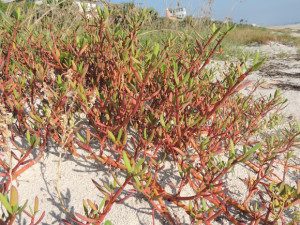
When Sea Purslane sequesters salt it turns pink. Photo by Green Deane
Sea purslane is not seasonal but it does favor the spring by putting on a lot of new shoots. By the time autumn falls the plant has been isolating salt from the water which turns its stems red. Thus one uses green stems as greens (boiled, roasted or stuffed in a fish or the like you are cooking) and the red stems for salt or seasoning. The older stems also get a woody core so one usually does not eat them. Young greens can be tossed right on the grill and wilted for a wonderful flavor. Sea purslane will also happily grow in your non-salty garden. It competes successfully in salty areas but does not have to be in salty ground. If you grow it at home it is not salty. To read more about sea purslane go here.
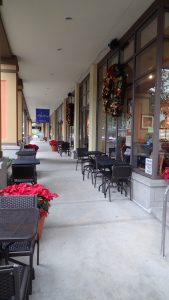
Panera’s in Winter Park where we start and finish the Urban Crawl.
My annual Urban Crawl is coming up, my tenth on Dec. 18th. A reasonable question is what about foraging in a city? There is some surprising research. Dan Brabaner is a geoscience professor at Wellesley College, Boston. With some undergraduate students they studied preserved food collected from fruit trees and the like in the urban Boston area. What they found was cherries, apples, peaches and herbs were relatively low in lead and arsenic. That is, a serving had less amounts of these toxins than the allowed daily amount for a child. The team also did not find a significant difference between peeled and unpeeled fruit. The fruit was low in toxic chemical because they are the furthest away from any toxins in the soil. This would apply to tree nuts as well. Leafy greens faired well, too, because they grow fast and 1) don’t have time to accumulate toxins and 2) most air pollution on them can be washed off. Brabander also analyzed foraged food from plants growing in the urban environment not growing on agricultural soil. These foods had higher micronutrients because they were not growing on worn-out agricultural soil. Calcium and iron were higher as were manganese, zinc, magnesium and potassium. Thus we know that not only do “weeds” pack more of a nutritional punch because they are wild but also because they can be growing in better soil. MY Urban Crawl is a fee class Friday Dec. 18th in Downtown Winter Park. We meet in front of Panera’s at 10 a.m. We wander south to the college, stop at Starbucks, go east to the public library area, then back to Panera’s.

Green Deane videos are now available on a USB.
A 150-video USB or 135 video DVD set would be a good winter present and either is now $99. My nine-DVD set of 135 videos has been selling for seven years and are still available. They are the same videos I have on You Tube. Some people like to have a separate copy. A second option is a16-gig USB that has those 135 videos plus 15 more. While the videos can be run from the DVDs the videos on the USB have to be copied to your computer to play. They are MP4 files. The150-video USB is $99 and the 135-video DVD set is now $99. The DVDs will be sold until they run out then will be exclusively replaced by the USB. This is a change I’ve been trying to make for several years. So if you have been wanting the 135-video DVD set order it now as the price is reduced and the supply limited. Or you can order the USB. My headache is getting my WordPress Order page changed to reflect these changes. We’ve been working on it for several weeks. However, if you want to order now either the USB or the DVD set make a $99 “donation” using the link at the bottom of this page or here. That order form provides me with your address, the amount — $99 — tells me it is not a donation and in the note say if you want the DVD set or the USB.

Green Deane Forum
Want to identify a plant? Perhaps you’re looking for a foraging reference? You might have a UFO, an Unidentified Flowering Object, you want identified. On the Green Deane Forum we — including Green Deane and others from around the world — chat about foraging all year. And it’s not just about warm-weather plants or just North American flora. Many nations share common weeds so there’s a lot to talk. There’s also more than weeds. The reference section has information for foraging around the world. There are also articles on food preservation, and forgotten skills from making bows to fermenting food.
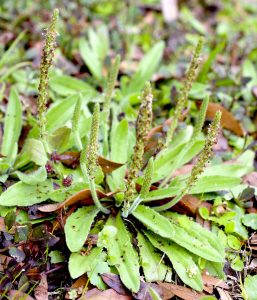
Our little native plantain is ramping up its seasonal appearance. Photo by Green Deane
This is weekly newsletter #432. If you want to subscribe to this free newsletter you can find the sign-up form in the menu at the top of the page.
To donate to the Green Deane Newsletter click here.


Could you please post the link to the research you refer to above by Dan Brabaner, the geoscience professor at Wellesley College, Boston?
I’m interested to grow edible mushrooms in my back garden. However , before starting, I want to make sure with which l can begin safely.
I like your comment on what oyster mushrooms do on logs as their main job. They do it and leave as ashes. Indeed this is typial wisdom. It exemplifies the temporary existence in this universe. Nothing exists for ever and absolute permanence is only for Him God Almighty. During my writing I’ve come across ” Kelp ” watching this in CNN tv. Channel. I thought the readers maybe referred to it – not a plant – but as an algae belonging to the order Laminariales. Kelp is famous to occur in the environment of the small Rathlin island lying off the northernmost tip of Northern Island.
Indeed dear Green, as you’ve mentioned about what oyster mushrooms do on logs, ” every thing in this life is temporary.